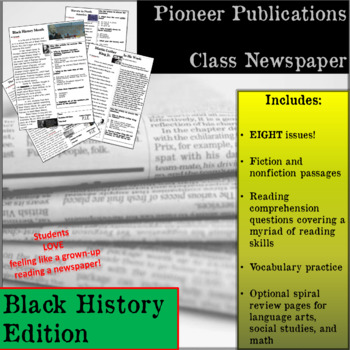Pioneer Publications Class Newspaper - Black History Editions
Learning Pioneers
109 Followers
Grade Levels
2nd - 12th, Homeschool
Resource Type
Standards
CCSS2.NBT.A.1
CCSS2.NBT.A.1b
CCSS2.NBT.A.2
CCSS2.NBT.A.3
CCSS2.NBT.A.4
Formats Included
- PDF
Learning Pioneers
109 Followers
Also included in
- Studying Black History? This bundle offers many ways to teach Black History, both print and digitally! It includes PowerPoint teaching slides, worksheets with a strong ELA focus, hands-on practice with vocabulary matching and clip cards, class "newspapers", an I Have Who Has game, vocabulary crosswoPrice $45.00Original Price $56.00Save $11.00
Description
Want a way to teach, practice, and review reading, language arts, social studies, AND math skills in a rigorous and engaging way? These class newspapers have IT ALL! They can be used for morning work, in centers, for independent practice, or whole group instruction!
These editions each have a different article pertaining to topics related to Black History. In addition to a strong social studies focus, each one includes reading comprehension questions and foundational math and language arts practice/review.
Looking for other ways to engage students in Black History studies? Learning Pioneers has a multitude of hands-on activities such as:
Black History: Slavery and the Underground Railroad Vocabulary Matching Cards
Total Pages
Answer Key
N/A
Teaching Duration
N/A
Report this resource to TPT
Reported resources will be reviewed by our team. Report this resource to let us know if this resource violates TPT’s content guidelines.
Standards
to see state-specific standards (only available in the US).
CCSS2.NBT.A.1
Understand that the three digits of a three-digit number represent amounts of hundreds, tens, and ones; e.g., 706 equals 7 hundreds, 0 tens, and 6 ones. Understand the following as special cases:
CCSS2.NBT.A.1b
The numbers 100, 200, 300, 400, 500, 600, 700, 800, 900 refer to one, two, three, four, five, six, seven, eight, or nine hundreds (and 0 tens and 0 ones).
CCSS2.NBT.A.2
Count within 1000; skip-count by 5s, 10s, and 100s.
CCSS2.NBT.A.3
Read and write numbers to 1000 using base-ten numerals, number names, and expanded form.
CCSS2.NBT.A.4
Compare two three-digit numbers based on meanings of the hundreds, tens, and ones digits, using >, =, and < symbols to record the results of comparisons.




